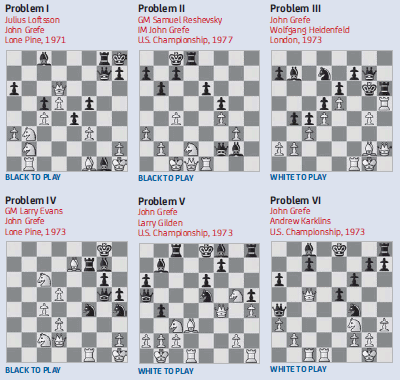It's not unusual that all five games have remarkably similar features. Chess combinations have a way of being repeated. It is very rare to come upon a truly original combination. This is why studying great tactical battles of the past is so useful.
It's not unusual? Why should it be otherwise? Since every game in every tournament -- chess960 tournaments excepted, of course -- has the same pieces starting on the same squares, and since every first move of those pieces goes to the same small set of target squares, what do you expect? Combinations showing the Bishop sitting on b1 or the Knight on d6 don't occur very often.
The following diagram shows the six positions that GM Soltis chose for his monthly puzzle set, a regular feature of his column. The positions are all from John Grefe games of the 1970s.

Take a good look at the positions. Three games have a Bishop sitting on the c/f start square, and four have the piece on the long diagonal. Five games have a Knight sitting on a square that can be reached on a single move move from its traditional start square.
In chess960, where the pieces often occupy squares that are unusual in traditional chess, original combinations occur in the majority of games. When you limit the number of start squares for the pieces, you limit the number of positions that arise from sequences of logical moves.

2 comments:
Mark, could you take a look at this very fun youtube video between Kevin Bordi (2274) and Kingcrusher (2496). I know you already have commented on Kingcrusher in a Chess960 video. Here is another for you!
5 games vs famous youtuber KingCrusher #Chess960
http://youtu.be/rKYBoYyeh0g
On another topic, I got the gist of your post here, but from the six images of the tactics, I couldn't exactly see how they back up your argument conclusively. May be a simpler example?
About making your Chess960 1-2-3 link clearer, I mean making it a bit clearer and bigger at the root of your blog, http://chess960frc.blogspot.com/ where you have the three links:
Home Chesscube Chess960 1-2-3.
I agree with Mark's remark that a new start setup position breeds new combinations that we rarely see with the traditional setup.
In my chess960 book I wrote about how in chess960-FRC the middle game phase is the same as traditional chess in some ways, yet is different in others.
"Is the Middle Game Really the Same?": No. And the differences are highly desirable for revealing variety that has long been hidden from us, which nevertheless feels entirely like it belongs as part of what chess is. Different but not alien or artificial. Different and natural.
When is the last time one of your own knights sat on a king-bishop-3 or queen-bishop-3 square? Very recent. But how long since on king-3 or queen-3; especially before the middle game was half over? Long time. Yet I insist there is nothing about what chess properly is that would disparage a knight on king-3 early in the game. This variety creates new challenges for control of the center; and I for one am disappointed I never get to see Carlsen and Caruana fight for the center under such a configuration.
GeneM, 2014-July-19
Post a Comment